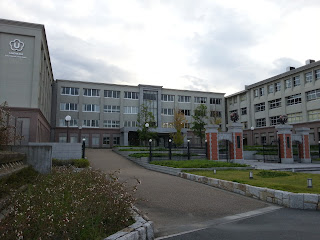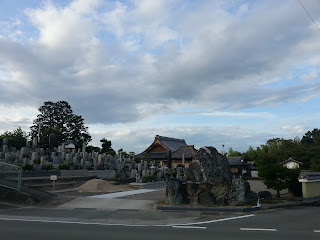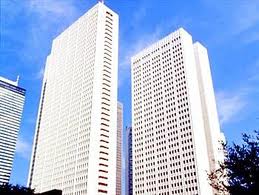This afternoon my wife informed me that she would be coming home a little late. So, since I was in no particular rush, and since it was a relatively cool afternoon with a nice dramatic skyline, I thought it was a good opportunity to create a photographic comic strip of my bike ride home from Matsusaka Commercial High School in Matsusaka, Mie Prefecture.
This photo was taken on Route 756, the road that my school is on, and I'm looking in the direction of home, with my school behind me.
Not far from the school you will find this very picturesque little cemetery. I think it's Shinto, but I'm not really sure.
Just opposite the cemetery is this little vegetable garden. Here I'm looking back in the direction of my school. You can see my silhouette on the pavement. :D
I live in a residential part of Matsusaka. Between my school and my home is a big rural area, and the main roads run around the rural area more-or-less a giant U-shape. There are some smaller roads inbetween that I attempt to navigate on my way home.
So from the previous photograph, I continue down the road for a while, turn left off Route 756. On this side of the road is a few rows of houses.
This panoramic shot didn't come out quite as clearly as I would have liked, but it's one straight road. Between the houses in this area are fields that are used for vegetables and occasionally rice. So even though the area is residential, there is some farming going on as well.
This photo came out a little better. Surprisingly again, this is again one straight road distorted by the panoramic function of my camera. (Go Samsung S3!) This road runs between a few rice fields. The field on the left has already been harvested, and only the stalks remain. The field on the right has yet to be harvested. In Japan, they are able to get about 3-4 yields of rice per field, per year.
The unharvested field above in all it's undistorted glory! :D
Similarly, this is the straight road I was talking about, with a beautiful view of the clouds that threatened rain... and delivered on it's threat! (But in truth it's bark was worse than it's bite.)
Samurai Scarecrow. Hmm... sounds like the name of a band :D.
A groupie of Samurai Scarecrow ;).
My journey home takes me literally under this tetanus threatening train track.
You can see where I emerge from under the train tracks in the diiiiistant right. Although it's not very clear, in the middle column here, in the distance is a romantic looking wire frame structure.
An undistorted view of the rice field and now I'm facing in the direction I am travelling. The illusion of being in a completely rural setting is about to be temporarily shattered.
But not before granting me one last beautiful view from an elevated perch at the top of the hill.
This K-store, a little convenience store ("combini" in Japan) is one of four or five K-stores I pass on my way home.
On the left is the combini I mentioned above. I'm facing in the direction of home. This road never looks busy, but a surprising number of cars pass through here daily.
(Yes I've recently discovered the panoramic shot option on my phone. :D.)
On this road I still get to enjoy lots of nature. There are farms on the left and the right, and here you can see some bamboo forest in the background.
 This man was kind enough to allow me to photograph him while he worked. I'm so surprised that the people harvesting the rice etc are really quite old by South African standards. Ok, some of them use a lot more machinery to get the job done, but I've literally seen woman that look like they're about 80 years old riding tractors through rice fields and as you can see here, elderly people are not afraid of doing physical work. Perhaps it's this physical work that keeps them strong and healthy for so long?
This man was kind enough to allow me to photograph him while he worked. I'm so surprised that the people harvesting the rice etc are really quite old by South African standards. Ok, some of them use a lot more machinery to get the job done, but I've literally seen woman that look like they're about 80 years old riding tractors through rice fields and as you can see here, elderly people are not afraid of doing physical work. Perhaps it's this physical work that keeps them strong and healthy for so long? If I could widen the field of view here you would seen the elderly gentlemen above in the bottom right of this photograph.
If I could widen the field of view here you would seen the elderly gentlemen above in the bottom right of this photograph.
I'm nearing the end of the road now, but not far from the end of the road is this beautiful Japanese building. I'm not sure whether it's a temple or a restaurant, but irrespective, it makes a pretty cool photo :D.
 The little dot you see suspended in the air is actually a spider suspended between tall trees on either side of the bicycle path.
The little dot you see suspended in the air is actually a spider suspended between tall trees on either side of the bicycle path.
At last you can we reach the end of the road.
On the left hand side you can see Matsusaka's private school. Mie High School, or in Japanese "Mie Koko".
 This is a full frontal photograph of Mie High School. At Mie High School I turn left into Miekodori, which is basically Mie (the name of the prefecture) Ko (school) Dori (street).
This is a full frontal photograph of Mie High School. At Mie High School I turn left into Miekodori, which is basically Mie (the name of the prefecture) Ko (school) Dori (street).
Miekodori is an urban street, and a fairly big road in the area. It doesn't stop them from farming rice wherever there's space however.
 This photograph was taken further down Miekodori and represents a fairly typical view of the roads in my area.
This photograph was taken further down Miekodori and represents a fairly typical view of the roads in my area.
I finally turn off Miekodori and an quite close to home now. Manicured Japanese gardens punctuate the sides of the roads on the way home. As you can see, the Japanese have a very different style of gardening :D.
Here is a panorama of the "pond" near our house. People fish here... often. It's not huge, but it's big enough to be difficult to circumvent.
And finally I turn left into my road; and I'm home :D.
Thanks for reading my blog. I hope you enjoyed this fairly detailed look at a segment of my experience that I re-live every day. :D




























